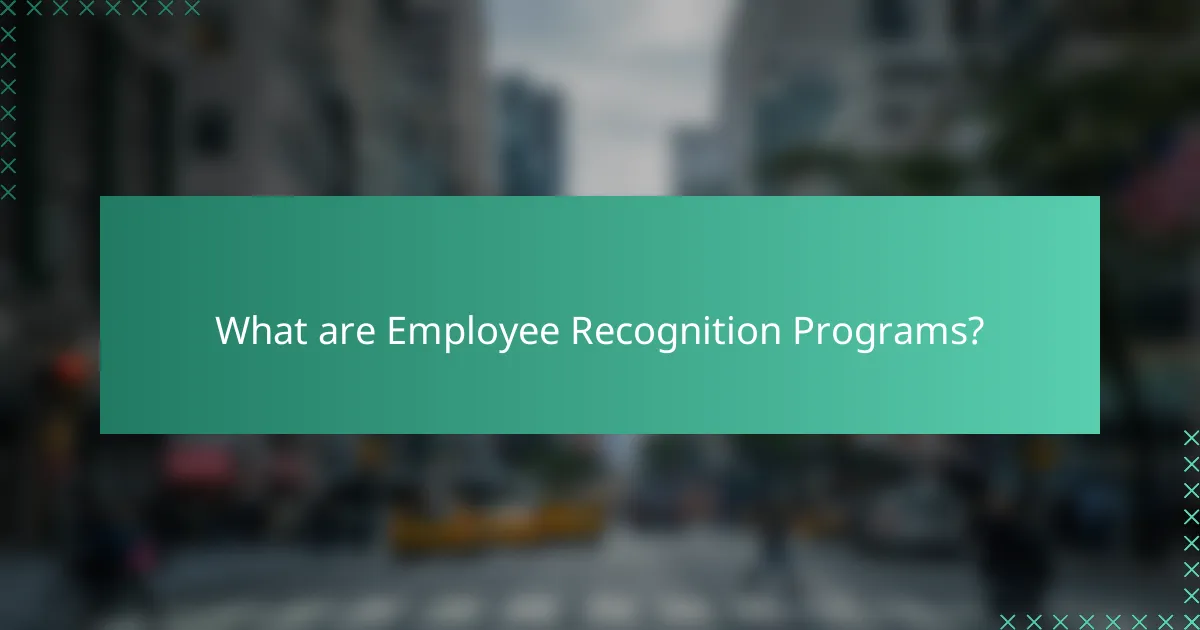Employee recognition programs are structured initiatives aimed at acknowledging and rewarding employees for their contributions to the organization. These programs can take various forms, such as awards, bonuses, or public acknowledgments, and are designed to enhance employee morale and engagement. The article explores different types of recognition programs, the benefits they provide—such as improved employee retention and performance—and methods for evaluating their effectiveness. Research highlights that organizations with effective recognition strategies significantly outperform those without, underscoring the importance of fostering a positive work environment.

What are Employee Recognition Programs?
Employee recognition programs are structured initiatives designed to acknowledge and reward employees for their contributions. These programs aim to enhance employee morale and engagement. They can take various forms, including awards, bonuses, or public acknowledgments. Such recognition fosters a positive work environment and encourages continued performance excellence. Research indicates that companies with effective recognition programs experience higher employee retention rates. According to a Gallup study, organizations with engaged employees outperform those without by 202%.
How do Employee Recognition Programs function?
Employee recognition programs function by acknowledging and rewarding employees for their contributions and achievements. These programs typically involve various methods such as verbal praise, awards, or bonuses. They aim to boost employee morale and motivation. Recognition can be formal, like annual awards, or informal, like a simple thank-you note. Programs often include peer-to-peer recognition systems, allowing coworkers to acknowledge each other’s efforts. Many organizations implement these programs to enhance workplace culture. Research shows that effective recognition can lead to increased productivity and employee retention. According to a study by the Society for Human Resource Management, 79% of employees say they would work harder if they were better recognized.
What are the key components of Employee Recognition Programs?
The key components of Employee Recognition Programs include clear criteria for recognition, diverse recognition methods, timely feedback, and employee involvement. Clear criteria ensure that employees understand what behaviors or achievements are recognized. Diverse methods, such as verbal praise, awards, and public acknowledgment, cater to different preferences. Timely feedback reinforces positive behavior and enhances motivation. Employee involvement in the design of recognition programs increases buy-in and relevance. Research shows that effective recognition programs can lead to a 14% increase in employee engagement, as noted by Gallup.
How do these components contribute to employee engagement?
Employee recognition programs significantly enhance employee engagement. These programs provide acknowledgment and appreciation for employees’ contributions. Recognition boosts morale and fosters a sense of belonging. Engaged employees are more productive and committed to their work. Studies show that organizations with recognition programs have 31% lower voluntary turnover. Additionally, 78% of employees report higher job satisfaction when recognized. Recognition also promotes positive workplace culture and teamwork. Overall, these components create a motivated workforce that drives organizational success.
What types of Employee Recognition Programs exist?
Types of Employee Recognition Programs include formal recognition programs, informal recognition initiatives, peer-to-peer recognition, and service awards. Formal recognition programs often involve structured systems where achievements are celebrated through awards or ceremonies. Informal recognition initiatives allow managers and colleagues to acknowledge efforts spontaneously. Peer-to-peer recognition enables employees to appreciate each other’s contributions directly. Service awards typically honor long-term employees for their loyalty and commitment. These programs aim to enhance employee morale and engagement, leading to improved productivity and retention rates.
What are formal recognition programs and how do they work?
Formal recognition programs are structured initiatives designed to acknowledge and reward employees for their contributions and achievements. These programs typically include awards, certificates, or public acknowledgments to celebrate employees’ accomplishments. They work by establishing clear criteria for recognition, which can include performance metrics, peer nominations, or management evaluations.
Formal recognition programs aim to boost employee morale and engagement. Research shows that organizations with such programs experience higher employee satisfaction and retention rates. According to a study by Gallup, companies with effective recognition programs can see up to 50% higher productivity.
These programs often involve regular ceremonies or events to honor recipients, fostering a culture of appreciation within the organization. By implementing formal recognition programs, companies can create a positive work environment that encourages continuous improvement and motivation among employees.
What are informal recognition programs and their benefits?
Informal recognition programs are initiatives that acknowledge employee contributions in a casual and spontaneous manner. These programs often include verbal praise, shout-outs in team meetings, or small tokens of appreciation. They foster a positive work environment and enhance employee morale. Informal recognition can lead to increased job satisfaction and motivation. Research shows that employees who feel recognized are more engaged and productive. A study by Gallup indicates that recognition can significantly improve retention rates. Informal recognition programs are cost-effective and easy to implement. They contribute to a culture of appreciation and strengthen team dynamics.
Why are Employee Recognition Programs important?
Employee recognition programs are important because they enhance employee motivation and engagement. Recognized employees are more likely to feel valued and appreciated. This leads to increased job satisfaction and productivity. According to a study by Gallup, organizations with high employee engagement are 21% more profitable. Additionally, recognition programs can reduce employee turnover rates. A report from Bersin by Deloitte found that companies with effective recognition programs have 31% lower voluntary turnover. Recognition fosters a positive workplace culture, encouraging collaboration and teamwork. Overall, these programs contribute significantly to organizational success and employee well-being.
How do Employee Recognition Programs impact employee morale?
Employee recognition programs significantly enhance employee morale. These programs foster a positive work environment. Employees feel valued and appreciated for their contributions. Recognition boosts motivation and job satisfaction. According to a study by Gallup, organizations with effective recognition programs have 21% higher productivity. This increase in productivity often correlates with improved employee engagement levels. Engaged employees are more likely to remain committed to their organization. Therefore, employee recognition programs play a crucial role in maintaining high morale within the workforce.
What role do Employee Recognition Programs play in retention?
Employee Recognition Programs significantly enhance employee retention. These programs foster a positive work environment and boost morale. Recognized employees feel valued and engaged in their roles. Engagement directly correlates with lower turnover rates. A study by Gallup found that organizations with high employee engagement see 25% to 65% less turnover. Recognition also strengthens employee loyalty to the organization. Employees who feel appreciated are more likely to stay long-term. Thus, effective recognition strategies are crucial for retaining talent.
How can organizations evaluate the effectiveness of Employee Recognition Programs?
Organizations can evaluate the effectiveness of Employee Recognition Programs through several methods. Surveys can measure employee satisfaction and engagement levels. Feedback from employees provides insights into the program’s impact. Performance metrics can assess changes in productivity and retention rates. Analyzing participation rates in recognition events indicates employee interest. Benchmarking against industry standards helps gauge relative effectiveness. Additionally, tracking changes in employee morale can demonstrate program success. These methods collectively provide a comprehensive view of program effectiveness.
What metrics should be used to assess Employee Recognition Programs?
Employee recognition programs can be assessed using several key metrics. These metrics include employee engagement scores, which measure overall satisfaction and motivation levels. Retention rates are also critical; they indicate how well the program contributes to employee loyalty. Participation rates reflect the number of employees involved in recognition activities, showcasing the program’s reach.
Additionally, performance metrics can evaluate the impact of recognition on productivity. Surveys can gather qualitative feedback on employee perceptions of the recognition program. Lastly, return on investment (ROI) calculations can assess the financial effectiveness of the program. Together, these metrics provide a comprehensive view of the program’s success and areas for improvement.
How can feedback be gathered to improve Employee Recognition Programs?
Feedback can be gathered to improve Employee Recognition Programs through surveys and focus groups. Surveys can be distributed to employees to assess their satisfaction with current recognition efforts. Focus groups can facilitate in-depth discussions about employees’ experiences and suggestions. Regular one-on-one meetings between managers and employees can also provide valuable insights. Utilizing anonymous feedback tools encourages honest responses. Tracking participation rates in recognition programs helps identify areas for improvement. Analyzing feedback data allows organizations to make informed adjustments. Research indicates that organizations with effective feedback mechanisms see a 14% increase in employee engagement.
What best practices should organizations follow when implementing Employee Recognition Programs?
Organizations should ensure that Employee Recognition Programs are inclusive and tailored to diverse employee preferences. This helps create a sense of belonging among all employees. Regularly soliciting employee feedback improves the program’s relevance and effectiveness. Additionally, recognition should be timely, acknowledging achievements as close to the event as possible. This enhances the impact of the recognition.
Setting clear criteria for recognition helps employees understand how they can achieve it. Transparency in the program fosters trust and engagement. Furthermore, integrating recognition into the company culture encourages ongoing participation. According to a Gallup study, organizations with effective recognition programs experience 14% higher employee engagement. This statistic supports the importance of implementing best practices in recognition programs.
How can organizations tailor their recognition programs to fit their culture?
Organizations can tailor their recognition programs to fit their culture by aligning the program’s values with the organization’s mission. Understanding the unique aspects of the workplace culture is essential. This involves assessing employee preferences and feedback on recognition types. Programs should reflect the organization’s core values, whether they prioritize teamwork, innovation, or individual achievement. For instance, a collaborative culture may benefit from team-based recognition initiatives. Additionally, incorporating diverse recognition methods, such as peer-to-peer recognition or formal awards, can enhance engagement. Regularly reviewing and adapting the program ensures it remains relevant to the evolving culture. Successful tailoring of recognition programs can lead to increased employee satisfaction and retention.
What common pitfalls should be avoided in Employee Recognition Programs?
Common pitfalls in Employee Recognition Programs include lack of consistency, insufficient communication, and failure to align recognition with company values. Inconsistent recognition can lead to confusion and feelings of favoritism among employees. Insufficient communication about the program’s purpose and benefits can result in low participation and engagement. Failing to align recognition efforts with company values can undermine the program’s effectiveness and employee morale. Additionally, neglecting to gather employee feedback can prevent continuous improvement. These pitfalls can diminish the program’s impact and reduce overall employee satisfaction.
Employee Recognition Programs are structured initiatives aimed at acknowledging and rewarding employees for their contributions, enhancing morale and engagement. The article outlines the various types of recognition programs, including formal and informal methods, and highlights their key components, such as clear criteria and timely feedback. It discusses the importance of these programs in improving employee retention, job satisfaction, and overall workplace culture, supported by research findings. Additionally, the article covers evaluation methods and best practices for tailoring recognition programs to fit organizational culture while avoiding common pitfalls.
